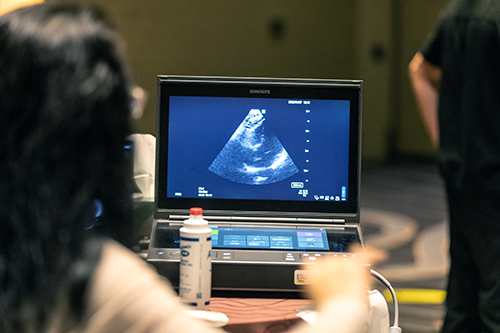 For a skill that is decidedly single-handed, many hands make lighter work for hospitalists focused on Point of Care Ultrasound (POCUS).
For a skill that is decidedly single-handed, many hands make lighter work for hospitalists focused on Point of Care Ultrasound (POCUS).
Hence the popularity of SHM’s POCUS Special Interest Group (SIG), formed in 2018 and now boasts 1,141 members.
“POCUS is relatively new, so we all need to support each other by helping others learn, and network,” said group co-chair Gordy Johnson MD, FACP, a hospitalist and medical director of POCUS at Legacy Emanuel Medical Center in Portland, Ore. “Networking is very important. But so is learning about how to learn, what you can do to train people, how you can learn yourself, what machines you can use, and reconciling and getting the support of other specialties.”
SHM has 27 SIGs that are sponsored by SHM to “create communities of hospitalists around topics of interest, practice areas, and/or care models.”
However, few change on the seemingly weekly basis that the POCUS group does, given the number of hospitals increasingly incorporating ultrasound as a daily practice.
“Often specific diagnostic management questions come up that intertwine radiology, cardiology, critical care, the emergency department, and hospital medicine,” said SIG co-chair Benji Mathews, MD, MBA, SFHM, whose titles include ultrasound director for hospital medicine for HealthPartners in Minneapolis-St. Paul.
“POCUS overlaps in multiple different arenas,” he continued. “From a quality assurance standpoint, it’s important to have interdepartmental collaboration. We encourage growing programs to collaborate with other POCUS users within their institutions so they may align where needed, troubleshoot early, and move conversations forward.”
At the same time, Dr. Mathews acknowledged that achieving a high degree of interdepartmental cooperation on POCUS remains difficult for some.
“Many pitfalls stem from ‘turf battles’ that are often due to the lack of understanding of the scope and purpose of ultrasound between departments,” he said. “Often, POCUS cases brought to specialists are ‘near misses’ or ‘errors’ and that lead[s] to availability bias and a representativeness heuristic—thinking that all POCUS users are more likely to acquire, interpret, and integrate suboptimal exams. A diverse interdepartmental team that listens and supports each other can help mitigate these pitfalls.”
Dr. Johnson noted that—given the growing popularity of POCUS—there’s often a lack of standardization within hospitals in addressing training, competency, and quality assurance. The POCUS SIG gives hospitalists an online community of fellow practitioners to be at the forefront of those conversations and assist in discussion with administration and other specialties, he said.
“Our group, in particular, is very supportive of each other,” Dr. Johnson said. POCUS “is a relatively new technology, and as we’ve all been learning this, we know the struggles that everyone has had. So, we want to minimize those struggles for those who are launching their own programs now. The general philosophy is that everyone rises together.”
Dr. Mathews believes that the ever-evolving nature of hospital medicine dovetails perfectly with the ever-innovating field of POCUS. A rotating quarterly series of webinars, journal clubs, and clinical case series, supplemented with social media engagement, helps keep members involved, as do events at the annual SHM Converge meeting.
“These special interest groups are where you can network with an amazing group of people who are innovators keeping up to date with the changing technology and devices, and the evolving training needs and education paradigms, and staying current regarding best implementation strategies,” he said.
“So, this varied group of novice to advanced learners, trainers, educators, and administrators can come into this rich POCUS community and receive on-the-go feedback. Rather than go to a one-and-done webinar, they become engaged in a community that helps provide practical tips and individualized resources. That’s the beauty of the SIG.”
Drs. Johnson and Mathews especially take pride in catering to early-career hospitalists and early-in-their-POCUS-career physicians.
“We try to level the hierarchy a little bit,” Dr. Mathews said. So whether they’re seasoned veterans or novices in ultrasound it’s all about “working together to gain valuable insights on how to grow together.”
Dr. Johnson notes that this type of career diversity is just one way the SIG attempts to reach out to as many constituent hospitalists as possible. “Dr. Mathews really pushed us early on to have broad diversity—geographic, academic versus community, gender, ethnicity, and urban versus rural—in the leadership so that we span the whole country,” Dr. Johnson said.
Diversity “provides a consortium of different perspectives, and we are pretty intentional on that,” Dr. Mathews said. “Diversity and equity need to be a forethought, not an afterthought. Unless we have a mix of ideas, we won’t grow in a way that’s truly representative and forward-thinking.”
Drs. Mathews and Johnson are eager to grow membership in the SIG and the potential to do so is within reach. There’s a larger pool of potentially interested doctors thanks to the increase in additional ultrasound training at medical schools and residences. And there’s increased incentive thanks to SHM’s Principles of Point-of-Care Ultrasound continuing medical education series. The series meets the online learning module requirement for the SHM-CHEST Point-of-Care Ultrasound Certificate of Completion program and is developed in collaboration with the American College of Chest Physicians.
Participation in “our certificate of completion pathway is also growing,” Dr. Mathews said. “You can see people are taking a lot of courses, and some of our seeds of networking are gaining roots. This has been a remarkable and exciting journey with POCUS and we’re so glad to share this with others.”
Richard Quinn is a freelance writer in New Jersey.